AMD Kaveri Review: A8-7600 and A10-7850K Tested
by Ian Cutress & Rahul Garg on January 14, 2014 8:00 AM ESTDrawing Performance Conclusions
As I progressed through the testing for this review, I became aware of trends in two things: absolute performance, in terms of numbers, and generational improvements across platforms. With AMD moving the Bulldozer based architectures from Piledriver in Trinity and Richland to Steamroller in Kaveri, the base CPU design has had a relatively long run in order to be optimized to the limitations on the CPU side. Obviously AMD has also had a chance to change the lithography node in there as well, and as such has optimized for design rather than performance. This matters a great deal when we look at the power banding (45W, 65W, 95W) and performance in each segment.
In order to display just how much Kaveri has grown in relation to the previous generations, I processed our mountain of data to show graphs where percentage gain against the older generations really does matter. As mentioned previously in this review, it all depends on whether the software can take advantage of the new features afforded by the architecture. In this review we have spent a lot of time discussing advantages for Kaveri in terms of compute (HSA, hUMA, hQ) and gaming (Mantle, TrueAudio), but some of these are still a little way off for software integration. So what does that translate to if you are looking for an APU today – does Kaveri still expand its wings with the integration of the GCN architecture, or does it lag behind due to the lithography node no longer being optimized for frequency. The proof is in the results.
IGP Gaming, 1280x1024
For the 100W APUs at 1280x1024, there is almost no movement between the Richland and the Kaveri APUs, except for Company of Heroes which would seem to leverage the extra SPs more than the MHz available.
45W APUs are clearly in vogue at 1280x1024, each of them providing a good bump over Richland.
IGP Gaming, 1680x1050
1680x1050 sees more benefit for the 100W APUs, but the 45W APUs still show big leaps.
IGP Gaming, 1920x1080
At 1080p the effects are more pronounced all around.
CPU Timed Benchmarks
Unfortunately the CPU timed benchmarks at 100W are bit over the place. Here we are dealing with an IPC gain but MHz deficit, and each benchmark has a different way of dealing with it. For Agisoft, MHz wins, but for Xilisoft, the Kaveri improvements work out well for the system.
At 45W the situation is a lot more clearer, and the newer APUs have the advantage, especially in Adobe After Effects.
CPU Score Benchmarks
45W still makes the biggest jump when it comes to score based CPU benchmarks.
IGP Synthetics
I never like putting much thought into the synthetic results – here both the 100W and the 45W range are showing good improvements all around. 3DMark 06 has the most trouble getting improvements as it relies more on the grunt, rather than the features that Kaveri affords.
IGP Compute
Off the bat we can see just how much of a difference the Kaveri GPU Compute can make over previous APUs. This is still without hUMA fully being in effect while we wait for a proper driver and software stack to become available.
Up to a +222% boost from Kaveri is amazing for a 45W part.
AMD vs Intel
For a little tete-a-tete, putting the 65W Iris Pro up against the 65W Kaveri seems like a good idea. To add to the mix, due to the extreme price difference of Iris Pro in this equation, we also add the 95 W Kaveri for comparison.
It is interesting to note that at the lower resolutions the Iris Pro wins on most benchmarks, but when the resolution and complexity is turned up, especially in Sleeping Dogs, the Kaveri APUs are in the lead.


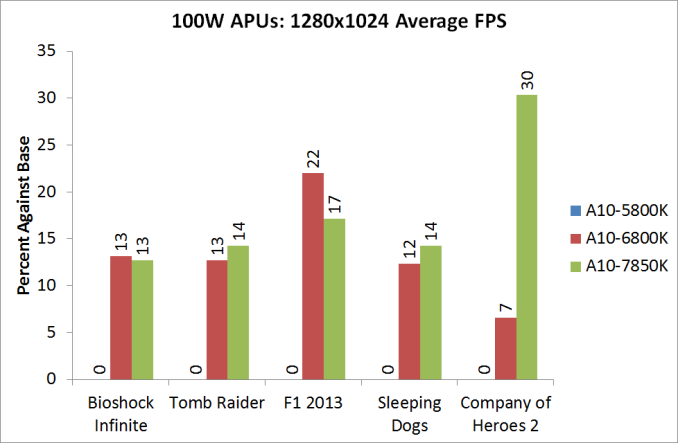
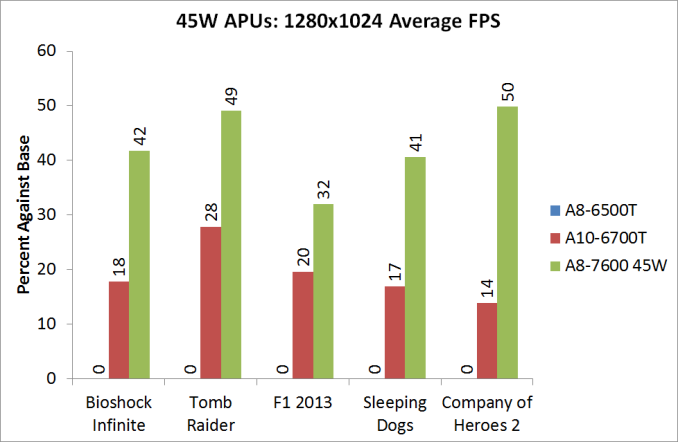
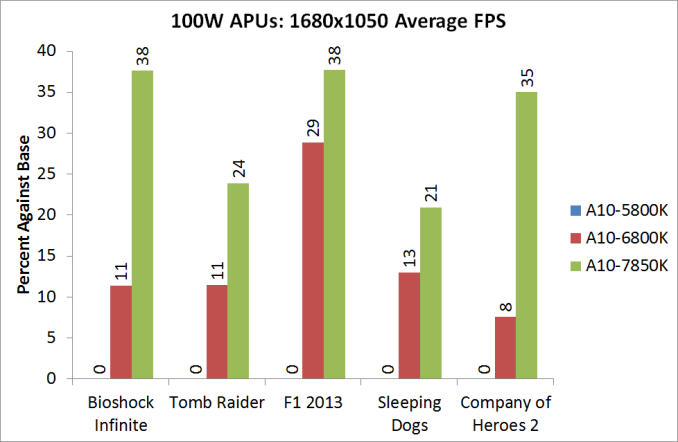
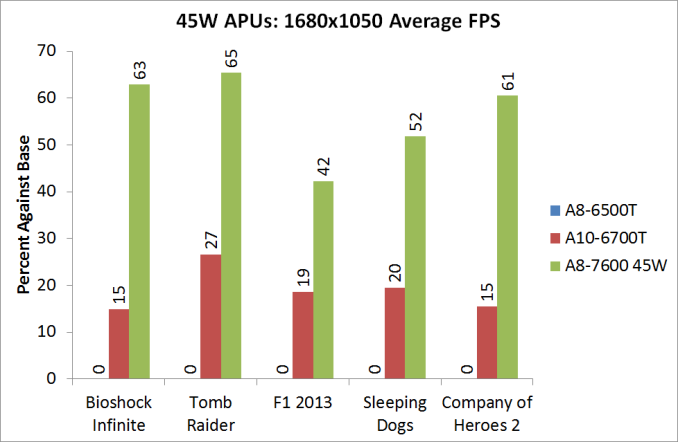
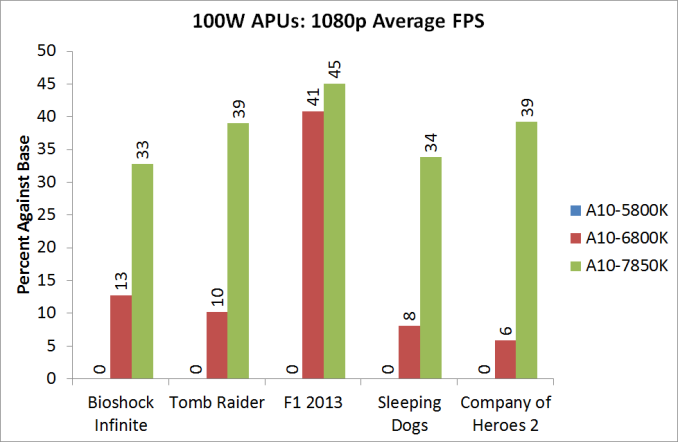

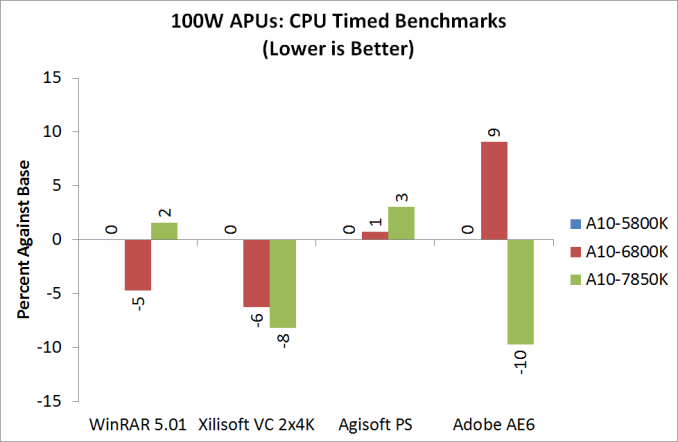
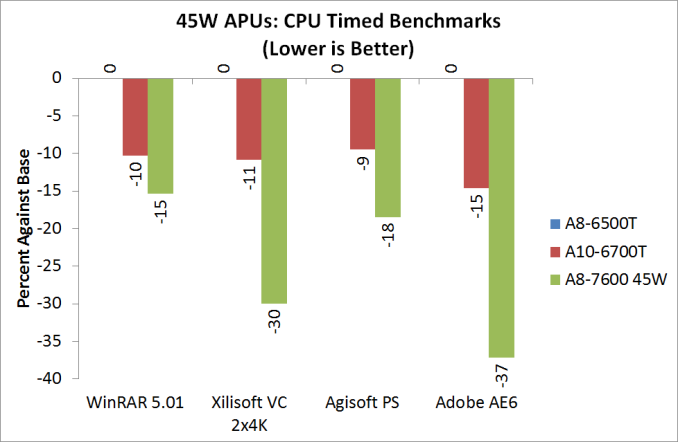

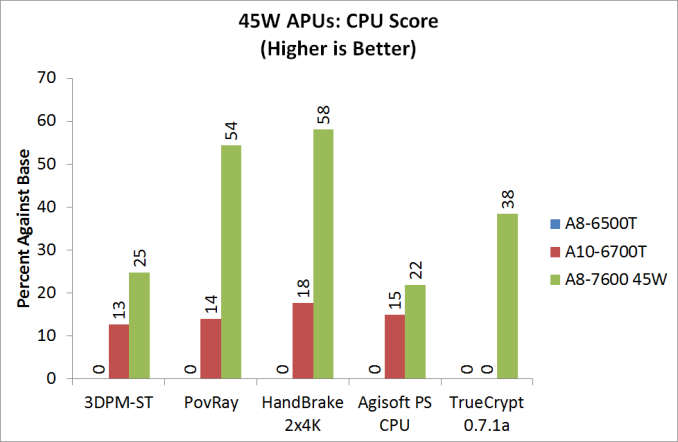
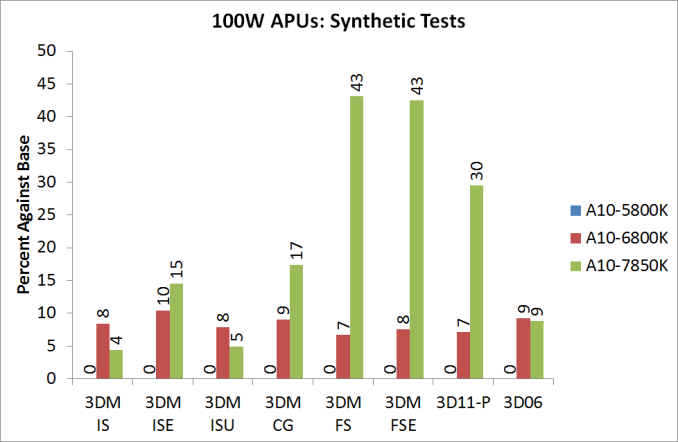
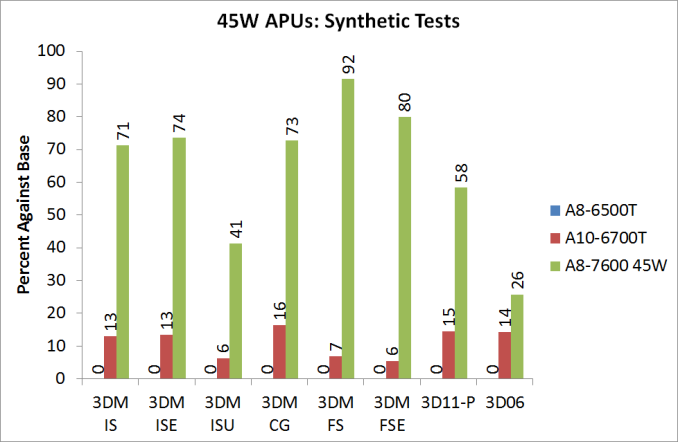
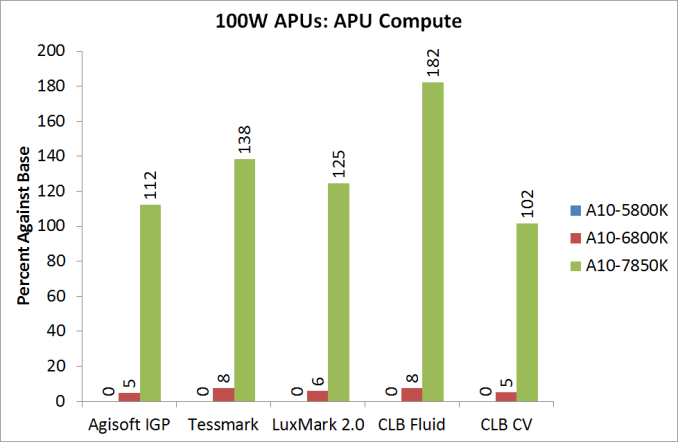

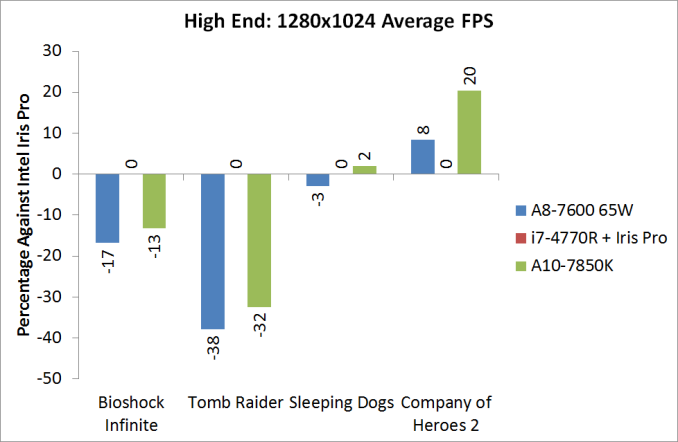
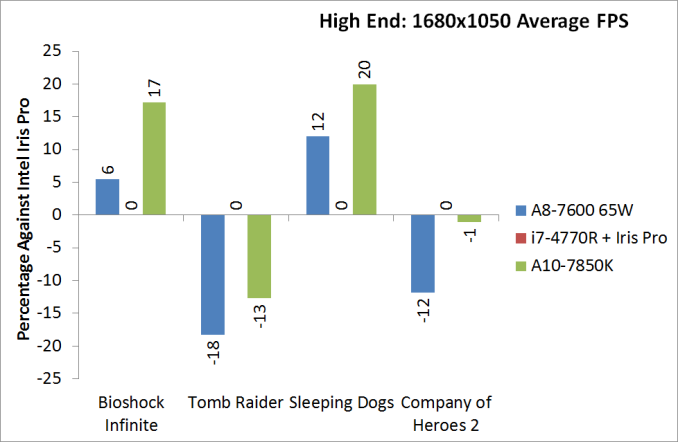
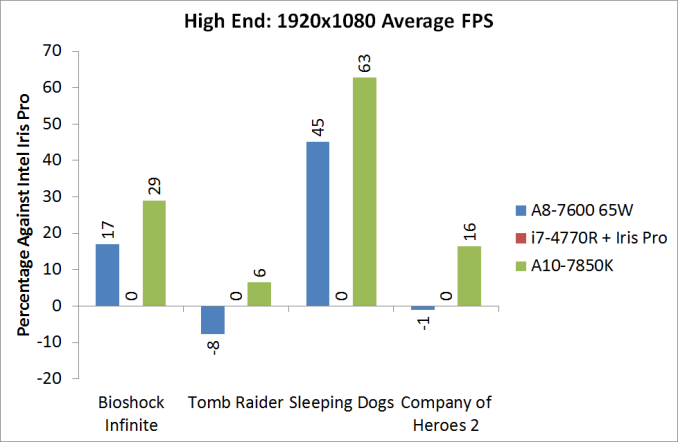








380 Comments
View All Comments
DanNeely - Tuesday, January 14, 2014 - link
This is the first I've heard that Excavator will be the end of the line for the current AMD core. Is there any information about what's coming next publicly available yet?JDG1980 - Tuesday, January 14, 2014 - link
It's all speculation because AMD hasn't released any roadmaps that far in advance. If I had to guess, I'd say they will probably beef up the "cat" cores (Bobcat -> Jaguar, etc.) and use that as their mainstream line. That would be similar to what Intel did when they were faced with a situation like this - they scaled up the mobile Pentium M to become the Core 2 Duo.jabber - Tuesday, January 14, 2014 - link
The great shame of these chips is the real market they should be selling in will never take off. These are perfect all round chips for those folks that buy a family PC in the usual PC mega store. That family PC would be your usual Compaq/Acer desktop with a decent enough Intel chip in it but the crappy Intel IGP only.But as AMD never advertises to these people (the people who should be buying this stuff) they will never buy them. The demand will never appear. They have heard of Intel, they hear the Intel jingle on the TV several times a week. But AMD? Never heard of them, they cant be any good.
Has anyone at Anandtech ever got round to interview the lazy idiot in the AMD marketing dept? Does AMD really have a marketing dept?
AMD, sometimes you do have to push the boat out and make the effort. Really stick it under ordinary peoples noses. Don't bother keep brown-nosing the tech review sites cos most of their readers don't buy your stuff anyway.
UtilityMax - Tuesday, January 14, 2014 - link
AMD can't market the APUs directly to the average consumers. They just buy what the PC mega-store sells to them. AMD should convince the OEMs, and that is _really_ hard. First is the issue of Intel quasi-monopoly. Intel always browbeat the major EOMs to ignore AMD. Even after losing the lawsuit, I think this effect still exists. And then next issue is that, your typical average consumer does not play on PC. They play on consoles. In fact, hardly anyone buys a PC box these days. Everyone buys laptops, and AMD's strategy there is just as weak.ThreeDee912 - Tuesday, January 14, 2014 - link
They tried to get OEMs to put Llano chips into "thin and light" laptops, but Intel kind of beat them with their Ultrabook marketing.At least AMD kind of "won" the console wars by getting their CPUs into both the PS4 and XBone.
xdesire - Tuesday, January 14, 2014 - link
Sorry but i read it like this: this is another piece of sht hardware which is YET another disappointment for their fans. I owned many of their CPUs GPUs and stuff but enough is enough. They have been laying their a**es off for SO long and couldn't even make an improvement on their crap stuff. So, is this THE Kaveri we were promised for so long? I supported them in their worst days by buying their products, hoping to see them come back in the game BUT no, they are being lazy and don't improve sht..jabber - Tuesday, January 14, 2014 - link
Dear AMD marketing Dept, the above post signifies what I said in the last part of my last post.This is not the market/customer you are looking for!
jnad32 - Tuesday, January 14, 2014 - link
Actually a 30% performance improvement seems pretty amazing to me. Also please try and remember that all these tests are done with very early drivers. We all know AMD takes forever to get there drivers in line. I wouldn't personally worry about numbers for the next couple of months. BTW, what were you expecting from an APU? Core i5? HA! I am a massive AMD fan, but we all know that wasn't even possible. What I really want to know is where is my 8 core Steamroller chip.JDG1980 - Tuesday, January 14, 2014 - link
I was hoping for IPC in line with at least Nehalem. The low IPC is really killing the "construction equipment" cores, and it's increasingly looking like an unfixable problem. If Steamroller could have brought ~30% IPC gains as was initially rumored, then that would have been a good sign, but at this point it seems they'd be better off taking their "cat" cores and scaling them up to desktop levels, and dropping the module architecture as a failed experiment.silverblue - Tuesday, January 14, 2014 - link
A "construction equipment" (thanks) module actually gets an impressive amount of work done when taxed. The concensus has been to make software think a module is a single core with HT. I imagine that the cores will be fed better in single threaded workloads in that circumstance.I also imagine that a heavily threaded workload will extract the very best from the architecture now the MT penalty is gone.
One question about the review scores - all the testing was done on Windows 7 64-bit SP1 with the Core Parking updates applied. Would using Windows 8 or 8.1 make any real difference to the results or would it just benefit both AMD and Intel?